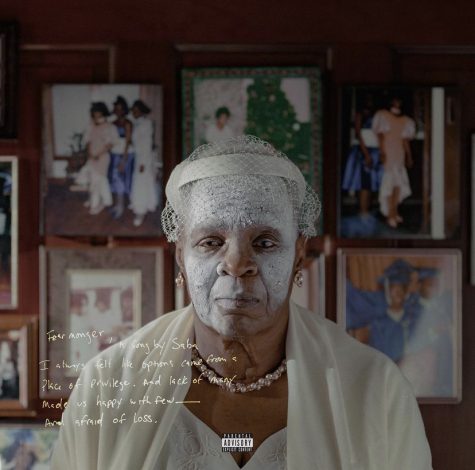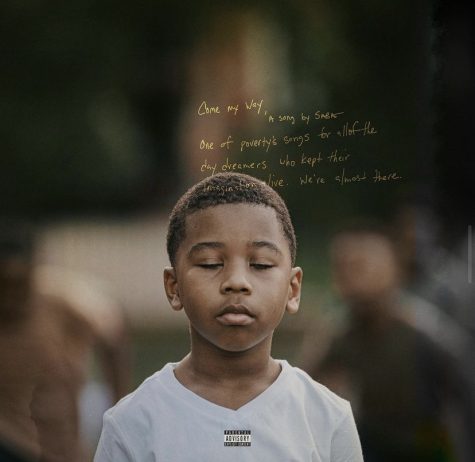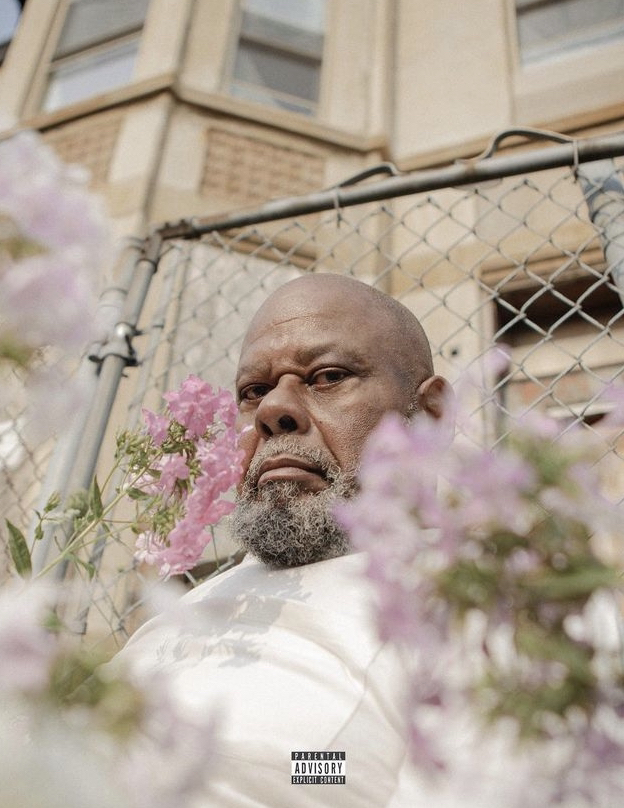Few Good Things explores the perspective of storytelling through personal experiences

More stories from Meghan Kennedy
The album cover for Few Good Things.
In early February, rapper and record producer Saba released his latest project, Few Good Things—but this work goes far beyond an album.
Growing up on the West Side of Chicago, Saba faced many hardships and detrimental losses. Despite these traumatic experiences, he has not let them define himself, his work, or the Black community as a whole. Through Few Good Things, Saba has composed a series of stories from the environment that surrounded his growing up. He transparently displays his experiences through the exact voice and emotion of his choosing. It’s a narrative of events that have happened within his family and community which have led him to the point where he is now.
The day before the album was released, Saba made a post on Instagram titled, “Before you listen,” explaining his work and intention behind what Few Good Things entails. He describes how this project is his way of clearing room for himself in the music industry to be able to represent himself and his experiences to the fullest extent.
One of the main points of this album is to accurately portray Black culture, but Saba isn’t just making blanket statements that tell the whole story for every Black person—in his post, he wrote, “I understand how it’s easy to only get grief and loss and suffering out of my music, but let’s acknowledge the full spectrum of black emotion when dealing with this album. We grieve. And we also celebrate . . . And we are more than one thing all at the same time.” Later in the post, he wrote, “Our culture is not clickbait,” reiterating that Black culture is not to be exploited for popularity, trends, and profit.
It is infinitely clear that Few Good Things is a meticulously crafted musical work that requires a sense of understanding to listen to and learn from. I acknowledge that I am a white person writing my own interpretations of what Saba’s music means and cannot understand exactly everything that he went through, but words cannot describe how much I appreciate and relish this album. After I did my best to educate myself on the relevant checkpoints of Few Good Things, the impact of the music hit me.
With a building haze of bird songs, boughs of violins, and light pattering drum beats, the song “Free Samples” introduces the album with the summer air of a suburban Chicago neighborhood.

Soon after, “Survivor’s Guilt” tackles the initial laid-back feel of the album with hard-hitting verses and a punching chorus. This song covers Saba’s interpersonal relationships, his gain of success, the lessons he learned, and the responsibilities he has taken on as a result.
The track list continues to flow, trickling into one of the highlights of the album: “Fearmonger.” Just as the title indicates, the song examines the fears and instability that ran through Saba’s community, particularly about lacking basic necessities. Though these problems posed great threats, “Fearmonger” shows that he powered through and made do with what he was dealt. Juxtaposing the gravity of this song is a whimsical, upbeat tone coaxing in a harmony of voices.
“’Cause fearmonger live amongst us/I feel hunger, hunger/But guess I feel somethin’ at least/I need somethin’ to eat.”
Resonating with this issue, Saba wrote this song to depict the hold that fear had on him by characterizing it as a sentient being: a “fearmonger” driving him to uncertainty.
As “Fearmonger” burns down to just a wick, “Come My Way” emerges from a hot pool of wax, delivering rapid bars and a burning chorus. Featuring the renowned rapper Krayzie Bone, the two artists together reach a compelling sound and duo of unmatched speed and meaning. This is one of my favorites of the album as it comprises elements of hope mixed with a poverty-stricken reality through a highly catchy yet melancholic tone—the two themes would seemingly not blend, but this song is proof that they can through the work of a musical genius.
Without looking back, “a Simpler Time” seeps into the bloodline of Few Good Things. Paired with R&B artist Mereba—a staple in my playlists—the theme of leaving things behind for a seemingly better life is explored. A calm melody overtakes the choruses of this song while the lyrics showcase Saba trying to better his life by taking the extra steps to get there.

“Woke up today, said, ‘I’m gettin’ it right’/Been up some days and I been up some nights/I caught the plane and I didn’t look twice/All for the simplest life.”
Though he tries to put in all of this extra effort, Saba concludes that he isn’t perfect and won’t be, despite his dedication, wrapping up the song in simplicity.
Next, the song “2012” reminisces on the positive memories Saba experienced when he was younger. Through mellifluous lyrics, Saba sings how he had “everything he needed” when he was a kid. Going to the corner store, childhood friendships, and living in innocence sums up the nature of “2012” with a mix of melodies and steady, consistent verse delivery.
The very last song on the track list is by far my favorite. With the same title as the album itself, “Few Good Things” covers systematic issues in America, family history, and the duality of the good and the bad through a lens of remembrance and celebration. “Few Good Things” is seven minutes in length, exploring a soft, melodic chorus and powerful verses, intertwining interludes laced with bird chirps and rhythmic humming.
One lyric that I feel encapsulates the entire nature of the album that continually reverberates through this song is, “Bad things come in threes, good things come in few.” It melts into the fibers of Saba’s voice and creeps up the brick walls of lyrics like a determined vine.
Altogether, “Few Good Things” is one of the most thoughtful, beautifully composed songs I have heard in a while. This execution of composition radiates through every word spoken, every tone shift, and every second the song simply plays.
Though it felt like the album of Few Good Things would never end, it, unfortunately, had to. But as I was researching the fine details of this project, it turns out that Saba additionally released a short film for Few Good Things.

Immediately hopping over to YouTube, I searched up the film and began watching. Through my twenty-four minutes of viewing, I experienced beautiful and heartbreaking visuals, snippets of Saba’s songs, storytelling elders, and a look into where and how Saba grew up. The imagery of dilapidated buildings and Chicago neighborhoods was abundant, displaying the environment depicted in the album. Throughout the film, more insight is given about the history of Saba’s childhood home and his family members, as well as the racist past of America—especially in areas as such. The album already painted an elaborate picture, but the short film only furthered the beautiful intricacies of Saba’s work.
Every detail of Few Good Things resembled that of a scrapbook: stories told on torn-out pages, edges rough like crumbling pavement. The lyrics are written for the ones who shape communities, the ones who live with pain, and the ones who tell stories of both bad and beautiful moments.
It has been a privilege to have experienced Saba’s artistry and his latest project Few Good Things. Since its release, I’ve cycled through the songs countless times, never growing tired of their contents. Albums like these stick; they cling to both listeners and more importantly, the music industry. Few Good Things is undoubtedly gaining traction and is well on its way to making an impact for the greater good of a culturally diverse America.

Meghan. also known as Meggie, is living up her senior year on The Central Trend. Starting out with a new role as Podcast Manager, Meggie is looking forward...



























































































